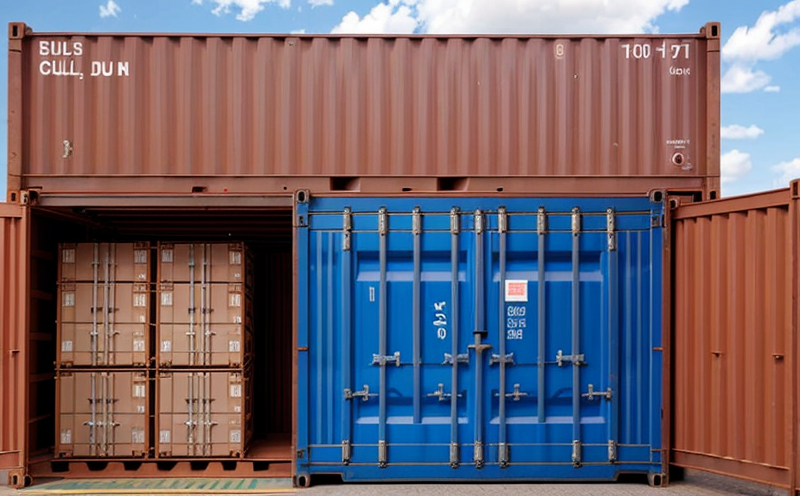USP Stopper Self Sealing Testing
The USP stopper self-sealing test is a critical component of pharmaceutical packaging and container closure system testing. This test ensures that rubber stoppers, which are used to close containers holding sterile products, maintain their integrity during shipping and storage conditions. Proper sealing prevents contamination from external sources such as microorganisms or particulates, thereby safeguarding the sterility and efficacy of medicinal products.
The USP 1208 and 1209 tests are part of the United States Pharmacopeia (USP) guidelines that outline this specific testing procedure. The self-sealing property is vital for ensuring product quality, especially in sterile pharmaceuticals where even minor breaches can lead to significant contamination risks.
During the test, rubber stoppers undergo compression with a specified force and are then held under pressure for a set period of time. After this duration, the force is released, allowing any seal leakage to be detected by visual inspection or more sophisticated methods like helium mass spectrometry leak detection systems (HMSL). The results of these tests directly influence decisions regarding product release into the market.
Understanding the importance of proper sealing in pharmaceutical packaging helps explain why compliance with USP standards is essential. Non-compliance can lead to regulatory actions and potential recalls, affecting both brand reputation and consumer trust. Therefore, implementing robust testing protocols such as those outlined by USP provides assurance that your products meet stringent quality requirements.
Compliance officers and R&D engineers play crucial roles in ensuring that all necessary tests are conducted correctly according to industry standards. They must stay updated on any changes or updates to these guidelines to maintain consistency across their processes. For procurement teams, understanding the nuances of this test can help them select suppliers who provide reliable materials.
The pharmaceutical sector places a high priority on maintaining product integrity throughout its lifecycle. This includes not only manufacturing but also distribution and storage phases where environmental factors could impact stopper performance. By adhering to rigorous testing procedures like USP 1208 and 1209, manufacturers can ensure that their products remain safe and effective.
In summary, the USP stopper self-sealing test is essential for pharmaceutical packaging quality control. It helps prevent contamination risks associated with improperly sealed containers while ensuring compliance with regulatory requirements. Understanding its significance allows stakeholders within the industry to make informed decisions about product safety and efficacy.
Applied Standards
| Standard | Description |
|---|---|
| USP 1208 | This standard specifies the procedure for testing rubber stoppers to ensure they can maintain their seal integrity under specified conditions. |
| USP 1209 | Details additional tests related to the functionality and performance of rubber stoppers used in pharmaceutical packaging. |
Why Choose This Test
The USP stopper self-sealing test is chosen because it ensures critical aspects of pharmaceutical packaging integrity, which are paramount for maintaining product quality and safety. By conducting this test according to USP guidelines, manufacturers can demonstrate their commitment to regulatory compliance and customer satisfaction.
Compliance with these tests helps prevent contamination risks that could compromise the sterility and efficacy of medicinal products. This is particularly important in sterile pharmaceuticals where even small breaches can have severe consequences for patients' health.
R&D engineers benefit significantly from thorough self-sealing testing as it provides valuable data on material performance under various conditions, aiding in process optimization and innovation. Quality managers rely heavily on accurate test results when making decisions about product release into the market, ensuring that only high-quality products reach consumers.
For compliance officers, adherence to USP standards like 1208 and 1209 ensures ongoing regulatory compliance, avoiding potential penalties or recalls. Properly sealing containers is crucial for protecting the integrity of sterile pharmaceuticals during transport and storage, which is essential for maintaining product quality.
Procurement teams also play a vital role in selecting suppliers who can provide reliable materials that meet stringent self-sealing requirements as stipulated by USP guidelines. By ensuring consistent performance across all stages of production, these teams contribute to overall supply chain reliability and efficiency.
Quality and Reliability Assurance
The importance of quality and reliability in pharmaceutical packaging cannot be overstated. Ensuring that rubber stoppers maintain their seal integrity is fundamental for protecting the sterility and efficacy of medicinal products, especially those classified as sterile pharmaceuticals.
Compliance with USP 1208 and 1209 tests guarantees adherence to strict regulatory requirements, providing assurance that suppliers meet industry standards. This not only protects against contamination risks but also enhances consumer trust in the brand's commitment to product safety.
R&D engineers can leverage accurate test results from self-sealing tests to refine manufacturing processes and improve overall performance of rubber stoppers. Their role is crucial in developing innovative solutions that enhance packaging integrity while meeting rigorous quality benchmarks.
Quality managers rely on consistent, reliable test outcomes when approving products for market release. They ensure that all necessary checks are completed before any item leaves the facility, maintaining high standards throughout every stage of production.
For compliance officers, staying up-to-date with USP guidelines ensures ongoing regulatory compliance and helps avoid potential legal issues or product recalls due to non-compliance. Their role is vital in safeguarding not only the company but also public health by enforcing strict quality controls.
In summary, the USP stopper self-sealing test plays a pivotal role in maintaining pharmaceutical packaging integrity. By following these procedures meticulously, manufacturers can ensure that their products remain safe and effective throughout their lifecycle.





